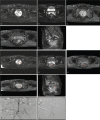Neoadjuvant intra-arterial versus intravenous chemotherapy in colorectal cancer
- PMID: 34941125
- PMCID: PMC8701446
- DOI: 10.1097/MD.0000000000028312
Neoadjuvant intra-arterial versus intravenous chemotherapy in colorectal cancer
Abstract
To investigate the clinical benefits of transcatheter arterial infusion chemotherapy compared with intravenous chemotherapy in patients with colorectal cancer (CRC).From May 2013 to March 2018, 83 patients (50 men and 33 women) with surgically proven CRC were retrospectively included. Before surgery, 62 patients received conventional systemic chemotherapy, and 21 transcatheter arterial chemotherapy. Basic characteristics, disease control rate (DC), adverse reactions, postoperative complications, and toxicity profiles were collected and compared between the 2 groups.The sigmoid colon (43.37%) was the most common primary tumor location, and the least was the transverse colon (6.02%). Most lesions invaded the subserosa or other structures T3-4 (78.31%), and other lesions invaded the muscular layer T1-2 (21. 69%). The overall DC was 80.65% in the intravenous chemotherapy group and 90.48% in the arterial chemotherapy group (P < .05). Adverse events included myelosuppression and gastrointestinal reactions such as nausea, vomiting, diarrhea, abnormal liver function, and neurotoxicity, which were significantly less common in the intra-arterial group than in the intravenous group (P < .05). Postoperative complications included abdominal infection (11.29% vs 14.29%), intestinal obstruction (6.45% vs 4.76%), anastomotic bleeding (1.61% vs 0.00%), and anastomotic fistula (6.45% vs 4.76%) in the intravenous and intra-arterial groups, respectively (P > .05).Preoperative transcatheter arterial infusion chemotherapy is a safe and effective neoadjuvant chemotherapy measure for CRC with fewer adverse reactions and a higher overall DC.
Copyright © 2021 the Author(s). Published by Wolters Kluwer Health, Inc.
Conflict of interest statement
The authors have no conflicts of interest to disclose.
Figures





References
-
- Arnold M, Sierra MS, Laversanne M, Soerjomataram I, Jemal A, Bray F. Global patterns and trends in colorectal cancer incidence and mortality. Gut 2017;66:683–91. - PubMed
-
- Chen W, Zheng R, Baade PD, et al. Cancer statistics in China, 2015. CA Cancer J Clin 2016;66:115–32. - PubMed
-
- Piedbois P, Rougier P, Buyse M, et al. Meta-analysis Group in Cancer. Efficacy of intravenous continuous infusion of fluorouracil compared with bolus administration in advanced colorectal cancer. J Clin Oncol 1998;16:301–8. - PubMed
-
- de Baere T, Tselikas L, Boige V, et al. Intra-arterial therapies for colorectal cancer liver metastases (radioembolization excluded). Bull Cancer 2017;104:402–6. - PubMed
MeSH terms
Substances
Grants and funding
LinkOut - more resources
Full Text Sources
Medical

